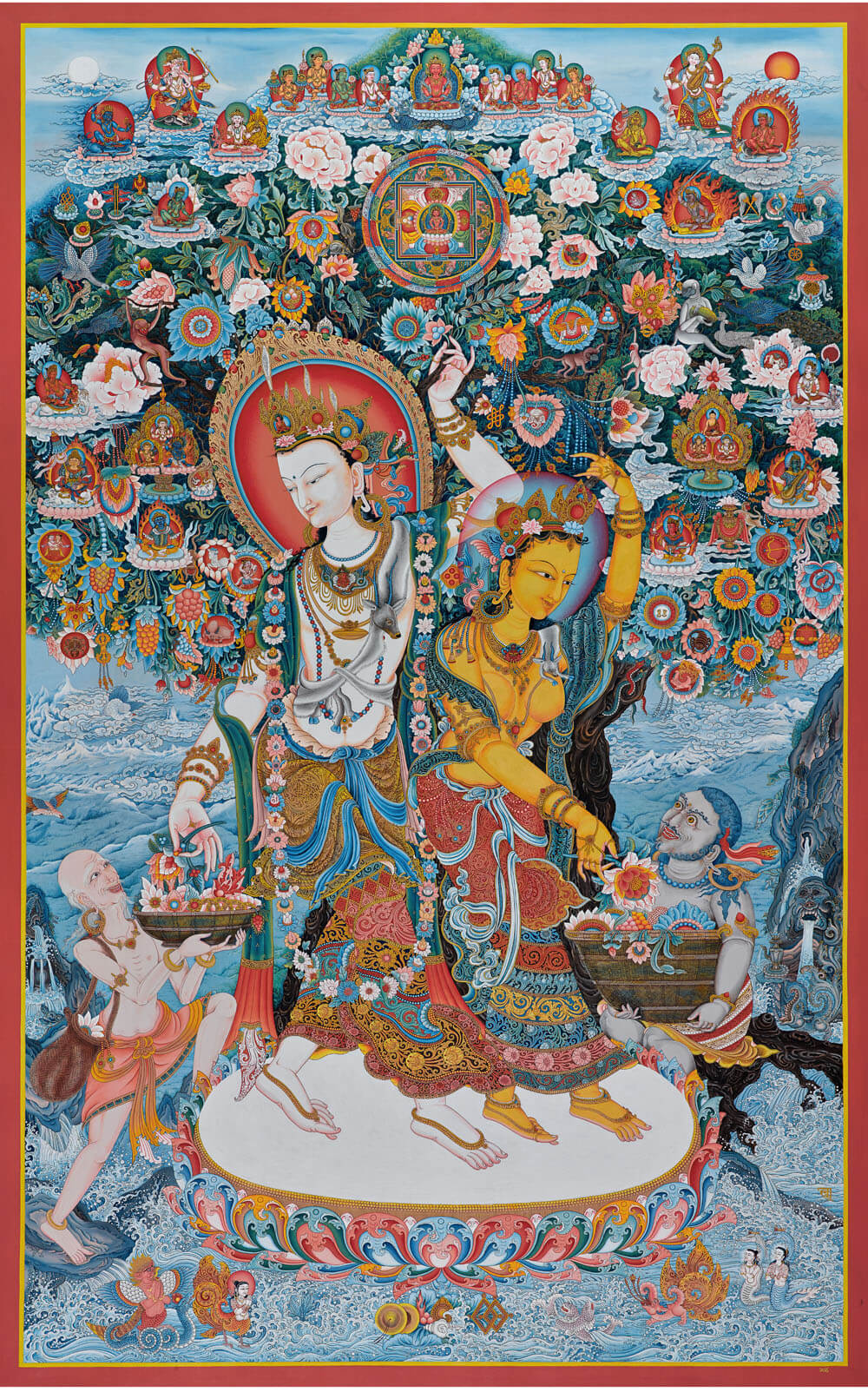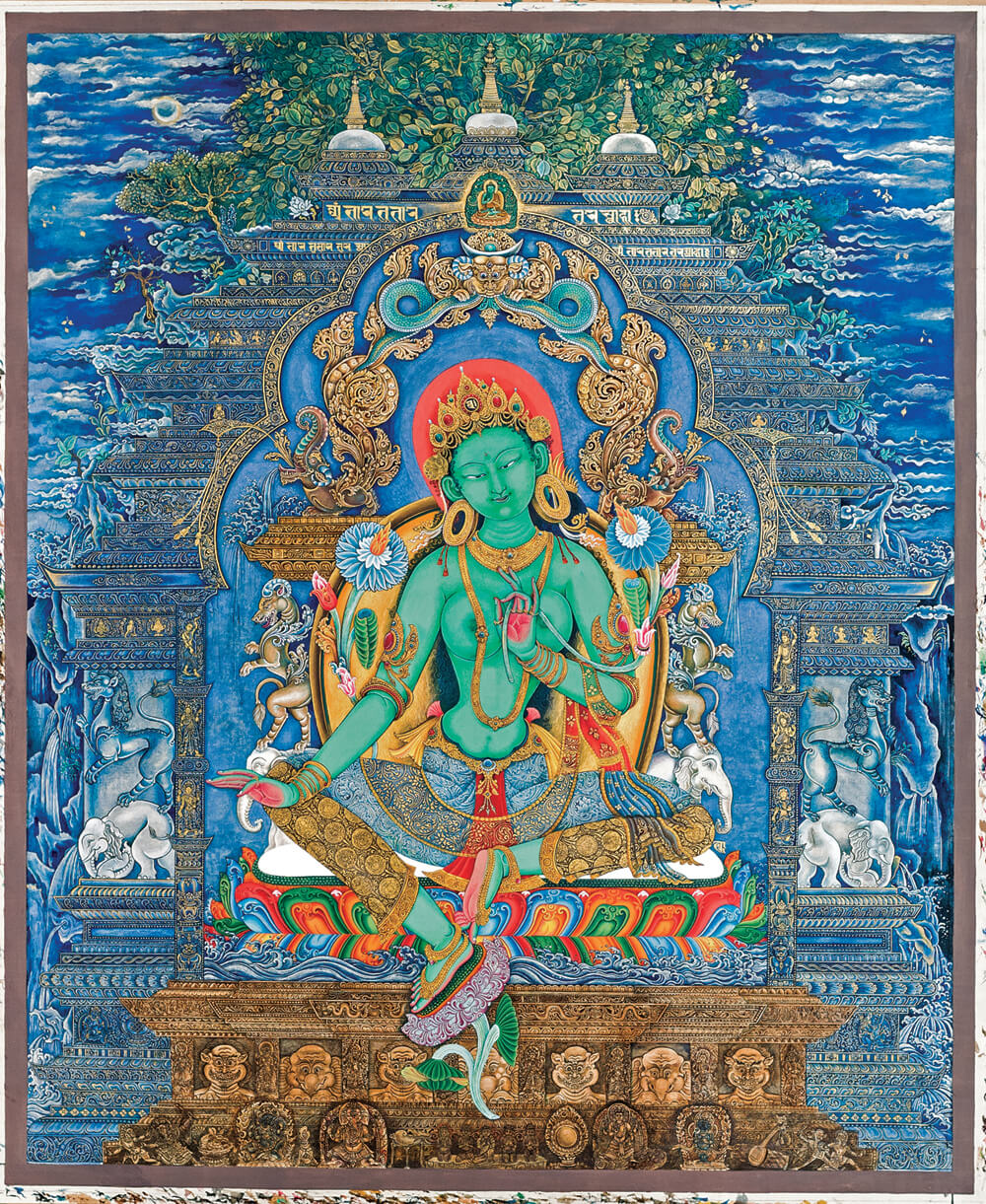Five Decades of Lok Chitrakar
The art of making the invisible visible through paubhaNobody completely understands the breadth and depth of our art which has developed over centuries. It takes more than a lifetime to achieve complete knowledge of an artistic heritage which is an amalgamation of religious philosophy, figurative symbols, metaphoric concepts and even subconscious outpourings.
Paubha is not just simply painting of a deity that follows iconography and elemental requirements. Paubha can consume every molecule of an artist, especially for a great master like Lok Chitrakar. He dives deep into our ancient art practices of traditional paubha, dabbles in issue-based paubha with realism and impressionism, and is also experimenting with contemporising paubha with abstract forms.
Our gods and goddesses are all figments of someone’s imagination. Ever wondered about the state of mind and emotional ecstasy of the first paubha painter? How did they render on canvas the compassion of a Green Tara, or the innate power of Lokeswor?
We can assume it was a combination of philosophical understanding, fervent religious belief and also a strong subconscious outpouring. As he comprehends the challenges of having to express philosophy through figures Lok Chitrakar agrees that our traditional art too began as abstract.
The subconscious plays a big a role when the artist has to imagine forms, expressions, colours, and movement of a deity who will evoke a powerful spiritual fervour. Moreover, it has to be visually stunning with intricate details. A dual talent of metaphorical and conventional skills and a sacred power of making the intangible, visible.
Today Wassily Condensky’s or Picasso’s forms and figures are used as the basis of abstract drawings by artists all over the world. Similarly, our traditional art too had a foundation of abstract notions that was given continuity and thus became traditional. Through centuries, many contributed to its greater evolution in style, design, and methods. Lok Chitrakar is a 21st-century master of preserving tradition, letting artistic styles evolve and revolutionise.

During his early days, there was limited information on paubha protocol as documentation was poor and ancient texts were not researched and translated. He went into great lengths to study the early texts of iconography including Buddhist and Hindu theology and to understand the philosophy behind the concepts. Thus, Lok Chitrakar’s art is not just about continuation of age-old techniques, but a homage to the talent of unknown ancient artists -- to revive it, and leave an indelible mark by preserving it for ages to come.
Understanding the depths of its philosophy so well, he breathes life into realistic, spiritual and abstract art forms.
Paubha art is the spiritual power of giving visibility to the deity one worships. An imaginative force of creative energy that brings the abstraction of god to life. A refined paubha artist like Lok Chitrakar has the ability to embody the presence and divine qualities of a deity.
Says Chitrakar: “Let people look at my paintings and let them forget themselves for a moment. Let it be a divine calling for them.”
Viewer may or may not get a calling, but they can see that divinity resides in those artists who have the power of making the unseen, seen.
HEVAJRA MANDALA

The greatest example of Lok Chitrakar’s artistic magnanimity is the Hevajra Mandala which has taken him 25 years, and is not yet complete. What drives an individual to assiduously work on a canvas for 25 years? How do you define such passion and dedication? It took 15 years for Da Vinci to complete 'Mona Lisa' and three years for 'The Last Supper'. It took four years for Michelangelo to finish painting the ceiling of the Sistine Chapel and two years for Botticelli’s 'Birth of Venus'. The world’s most famous and expensive art has been completed in less time, but Lok Chitrakar is still envisioning and studying the scriptures of Hevajra, a 500,000-verse tantric text of the Sakya order of Tibetan Buddhism that originated in the 8th century. The text converted to images in a mandala form is a lifetime of study.
The philosophy of the Hevajra is about the impermanence of all phenomena which the artist has been studying since the 90s. He cannot complete it until he personally experiences all its teachings, he explains. Many of the lessons learned within the span of 25 years has been painstakingly imbibed, and he continues to work on it as he ages and understands the philosophy further.
CHINTAMANI LOKESHWOR

Sometime in the 1980s, a 16th century art piece Chintamani Lokeshwor was stolen from Itum Bahal, and its whereabouts is unknown. Chitrakar would often go to study this paubha and he was terribly distressed by the loss of the national treasure. Based on the memory of what he saw, he was so inspired to paint this stolen masterpiece that he completed seven of them -- each one better than the previous. In doing so, he invented a new technique, which adds a transparent, almost reflective touch around the aura and shawl. Such was his determination to create the best version of the long lost paubha that his last one is beautiful beyond description.
The painting intricately depicts Chintamani and his consort generously giving donations. It took Chitrakar 10 years to complete the piece and the final parts were done during the time he was taking care of his ailing mother. Chintamani Lokeshwor is the Bodhisattva of altruistic compassion and his life situation then was similar to the philosophy. He felt blessed to be serving his mother compassionately during her last days.
TARA

This Tara is inspired by the 12th century Nepali artist Arniko which is an inspiration to most paubha artists. Lok Chitrakar does not just admire him, he beautified the classic painting and gave it his unique creative touch by going a step further and applying lapis and malachite mixed paint. He wanted to show the rich skills of the Newa school of paubha and our unique paint mixtures. He learned the art of mixing lapis in Japan and bought 15 grams of high-quality lapis for $300 especially for this painting. This is the first time in the history of paubha painting that lapis, malachite, gold, and silver mixtures have been used. Chitrakar added gold and silver mixtures in the deity’s jewellery and the green background is the purest lapis and malachite mix; a paint technique only familiar to him -- no other paubha artists have dared.
RAKTA GANESH

Lok Chitrakar has painted many forms of Ganesh but the most striking one is of Maha Rakta Ganesh, the red Ganesh which took him 16 years to complete. The inspiration is to bring to light the extraordinary talent of Jiva Ram, a less known Nepali artist of the 15th century who went to Tibet and mastered its artistic styles. In the 16 years it took to complete this piece, the canvas was eaten by termites, but Chitrakar continued to paint on it as a symbolic mark -- the holes can be still seen. As always, he added his own unique touches like the women holding the Asthamangal, a message of women empowerment within a strong representation of the male embodiment of Ganesh. The painting was completed during lockdown and he was so absorbed in it to emulate the artistic spirit of Jiva Ram that the turmoil of the Covid days didn’t affect him at all.
CONTEMPORARY CHAKRASAMVARA

Though Chitrakar is not completely satisfied with his abstract version of Chakrasamvara, the piece signifies a revolution in Nepali art. It is a unique artistic attempt to merge the traditional and the modern. Chakrasamvara means an absolute state of an enlightened, or awakened mind. Chitrakar portrays this in a contemporary manner: blending hand gestures, symbols and deities, it’s a striking splurge of spontaneity and protocol on canvas. Those who do not understand this tantric philosophy may be lost, but for those who do, it is a delight to analyse the art from a mixed perspective.
Lok Chitrakar: Solo Exhibition
26 March – 26 April 2023
Museum of Nepali Art, Thamel
Shaguni Singh Sakya is Director, KGH Group and Museum of Nepali Art (MoNA).




